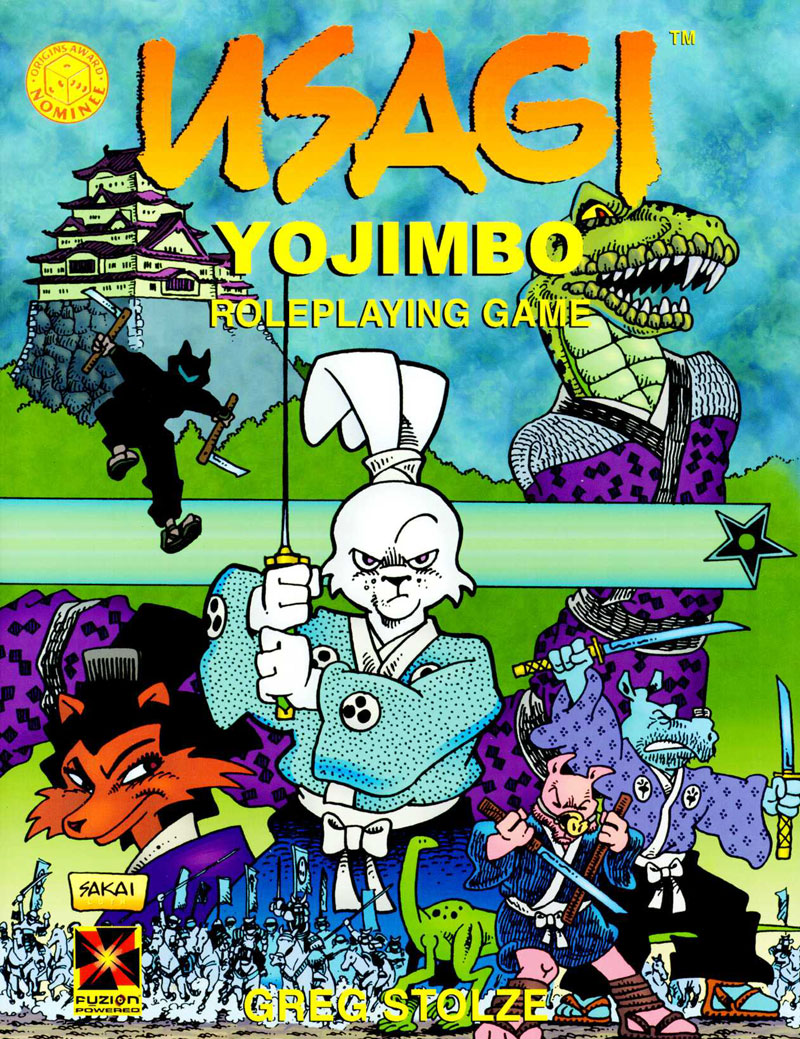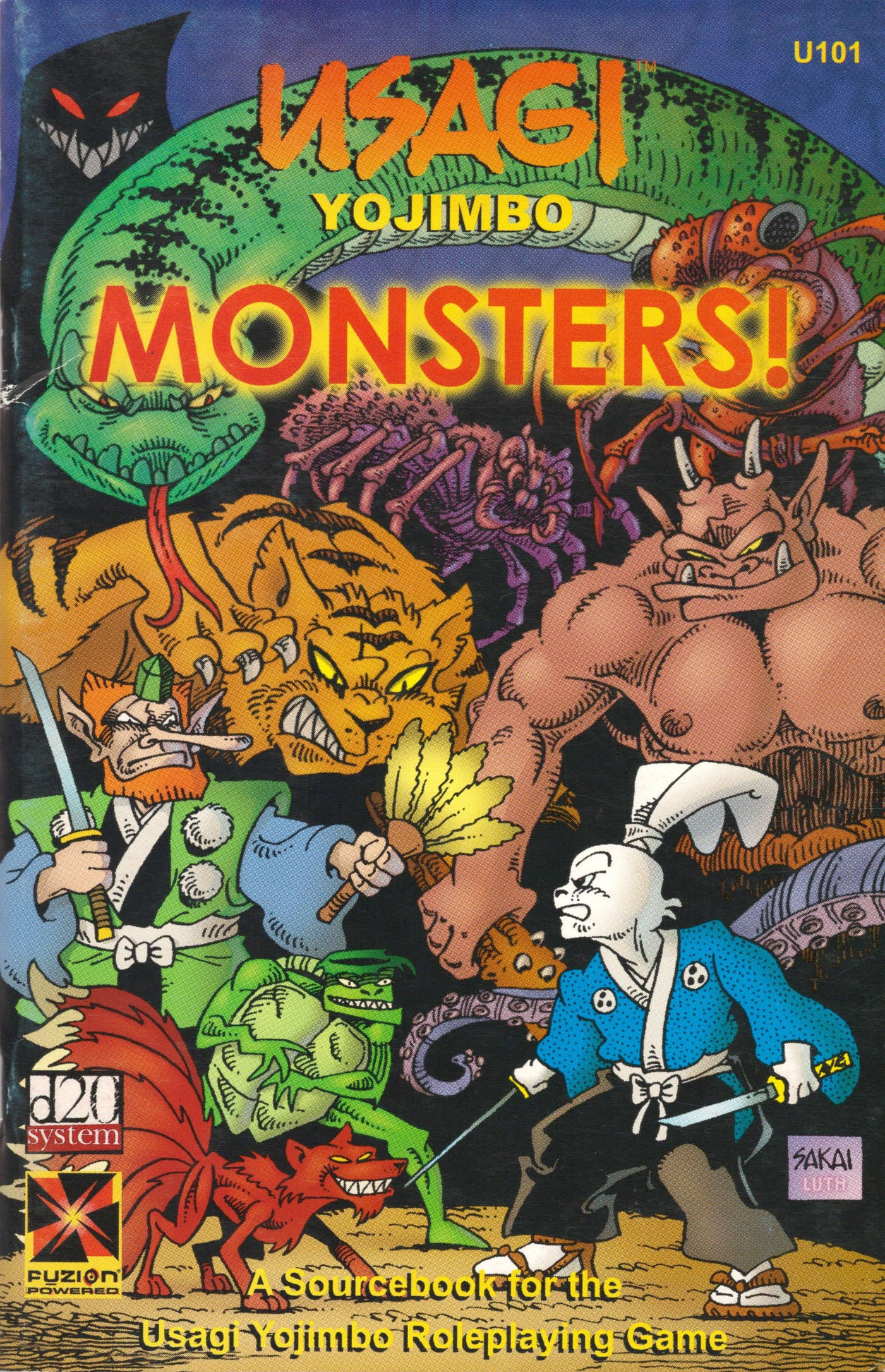
An excellent adaptation of its source material which, unfortunately, doesn’t offer much to anyone who isn’t already a fan of the comic book.
Review Originally Published December 28th, 2000
Usagi Yojimbo is a truly excellent comic book created by Stan Sakai. The title character is an anthropomorphized version of the historical Miyamoto Musashi. In other words: Usagi Yojimbo is a humanoid rabbit whose fictional exploits draw a sizable portion of their inspiration from the life of a 17th century Japanese samurai.
The Usagi Yojimbo Roleplaying Game, authored by Greg Stolze (a game designer whose past credits – including Unknown Armies – speak for themselves), is an adaptation of Usagi’s world for all of us gaming fanatics.
SYSTEM
The system used for Usagi Yojimbo is a modified version of the generic Fuzion engine – also used in Sengoku (also published by Gold Rush Games), Bubblegum Crisis, Armored Trooper Votoms, and Champions: New Millennium (among others). You can learn more about the basic Fuzion system from the Fuzion Labs website.
There are two significant changes to the basic system in Usagi, both of which are carried out very nicely:
First, the character creation process has been boiled down to a simple, three step process – with each step modifying a set of basic attributes and skills which are given to each character:
1. Pick a Species (bat, cat, rabbit, mole, etc. – anthropomorphic, remember?).
2. Pick a Job (bounty hunter, bodyguard, gambler, retainer, etc.).
3. Divide 10 extra points among skills in order to customize your character.
This Job/Species system could easily be mistaken for a traditional, D&D-style Class/Race system – but you shouldn’t do that. The system in Usagi is not a class system, but rather an archetype system. Unlike the rigid definitions of a class system, an archetype system is loose and open: The goal of a class system is to protect the niche of each character (a wizard has a very different role than a fighter); whereas the goal of an archetype system is nothing more than to simplify the character creation process. Instead of figuring out which skills you need to be an effective messenger, the system designer has done the work for you.
The other major modification to the system is in the combat mechanics. Stolze has designed an elegant combat system designed to convey the feel and spirit of a samurai duel.
As in almost any other combat game you care to name, initiative determines who goes first. This person chooses a target. At this point, though, something a little different happens – because in Usagi Yojimbo it is not just the attacker, but also the defender, who gets to take an action.
It works like this: Both combatants secretly choose one of three strategies – Total Attack, Cautious Attack, or Total Defense. Both combatants then reveal their choice of strategy simultaneously (Stolze suggests using standard playing cards to do this effectively). Now, depending on which strategies were chosen, combat can go one of several ways. For example, if both combatants chose Total Attack, then they both roll their combat roles (Combat + Weapon Skill + roll of dice), but whoever succeeds does double the normal damage.
The only restriction to this is that the person who initiated the attack cannot choose Total Defense as a strategy (since that would mean they weren’t initiating the attack). Other than that, both attacker and defender behave identically – a rather radical change from the normal methodology in combat system design (in which the roles of attacker and defender are very distinct), which provides a unique – and highly worthwhile – dynamic to the system.
There are a few more twists to it, including an optional system for handling unarmed combat which is similarly unique in its approach, but that’s the core of it.
In practice this process really shines – giving a feel to the mechanics which does a very nice job of mirroring the feel of samurai duels in fiction (including, of course, Usagi Yojimbo).
STRENGTHS
The primary strength of Usagi has already been discussed at length: Stolze has adapted the Fuzion engine to give the game an extremely simple, yet also extremely attractive, system. Both character creation and combat are not only dynamic systems, but simple ones. Excellent stuff all around.
A couple of other things are worth mentioning, though: First, a one page system reference chart is included. I love these things, and wish more games had them. This one, in particular, is extremely effective – summarizing every last element of the game system. Far too often you’ll get “reference charts” – usually on GM screens – which reference every knick-knack in the game except the rules you actually use on a regular basis. Usagi avoids this nicely.
Second, the book contains a number of appendices – which, as a general rule, contain extremely useful information: A timeline for the Usagi universe; a character index for the comic; one of the best “gamer’s glossaries” for Japanese I’ve seen (largely helped, no doubt, by the fact it’s based in the Japanese which occasionally crops up in the Usagi comic; and, finally, a FUDGE conversion for the game system.
Finally, the book is rounded out by a short Usagi story by Stan Sakai, “Hebi”. Nice stuff.
WEAKNESSES
Unfortunately, there are two major flaws with the Usagi Yojimbo game – and they both take their toll on what would otherwise be an exceptional game.
First, the layout leaves much to be desired. Although the book’s illustrations are helped greatly in quality by the fact they are drawn from the Usagi comic book, they also come complete with word balloons. The effect, along with some other questionable lay-out choices, give the entire book a cluttered, inaccessible feel – which is, at the same time, scattered in its focus. One of the worst moments of this layout comes in a chart which lays out the major samurai clans in Usagi’s world – which, unfortunately, looks like it was designed to be a butterfly ballot in Florida.
Second, and far more troubling, is the fundamental lack of world reference material to be found in the book. It is essentially constrained to a timeline (which is not generally useful in any sense of the word) and a chapter discussing the major characters which have appeared in the Usagi comic (which is further flawed in that it doesn’t provide coverage of several usual suspects). The GM is basically left on their own when it comes to filling in the actual gaming environment of ancient Japan.
CONCLUSION
The Usagi Yojimbo Roleplaying Game is an excellent adaptation of its source material. Unfortunately, its varied weaknesses mean that it isn’t going to do anything for anyone who isn’t already a fan of the source material. The lack of any serious world reference material is particularly distressing – particularly when contrasted against the wealth of what would be essentially identical material in Gold Rush’s Sengoku game.
In short: Fans of Usagi Yojimbo might want to flip through this one to see if it offers them anything of interest. Anybody else should definitely give it a pass.
Actually, let me modify that conclusion in one way: System nuts might want to check this one out just to take a look at the combat system which Stolze has set up. The strategy system – which gives the system a true claim to fame – is almost a cap-system: It would be easy to pop it off of Fuzion and onto any standard combat system in the industry. If you’re tired of just rolling dice during combat, this might be worth your time.
Style: 4
Substance: 3
Grade: B
Title: Usagi Yojimbo Roleplaying Game
Authors: Greg Stolze
Company: Gold Rush Games
Line: Usagi Yojimbo
Price: $16.00
ISBN: 1-890305-02-2
Production Code: U100
Pages: 96
Originally Posted: 2000/12/28
I’m old enough that when someone says “furry” what I think of is stuff like Usagi Yojimbo and Cerebus. It’s interesting how a fetish-driven fanbase has really driven the whole anthropomorphic genre into a niche of a niche.
Conversely, it’s remarkable the degree to which D&D 3rd Edition rehabilitated the whole concept of class-based RPGs. Used to be everyone who left D&D to play other RPGs would collectively sigh with relief at never needing to play a class-based system with all of its silly limitations again. Now classes clearly rule the roost.
Review: Usagi Yojimbo – Monsters!
For an explanation of where these reviews came from and why you can no longer find them at RPGNet, click here.













